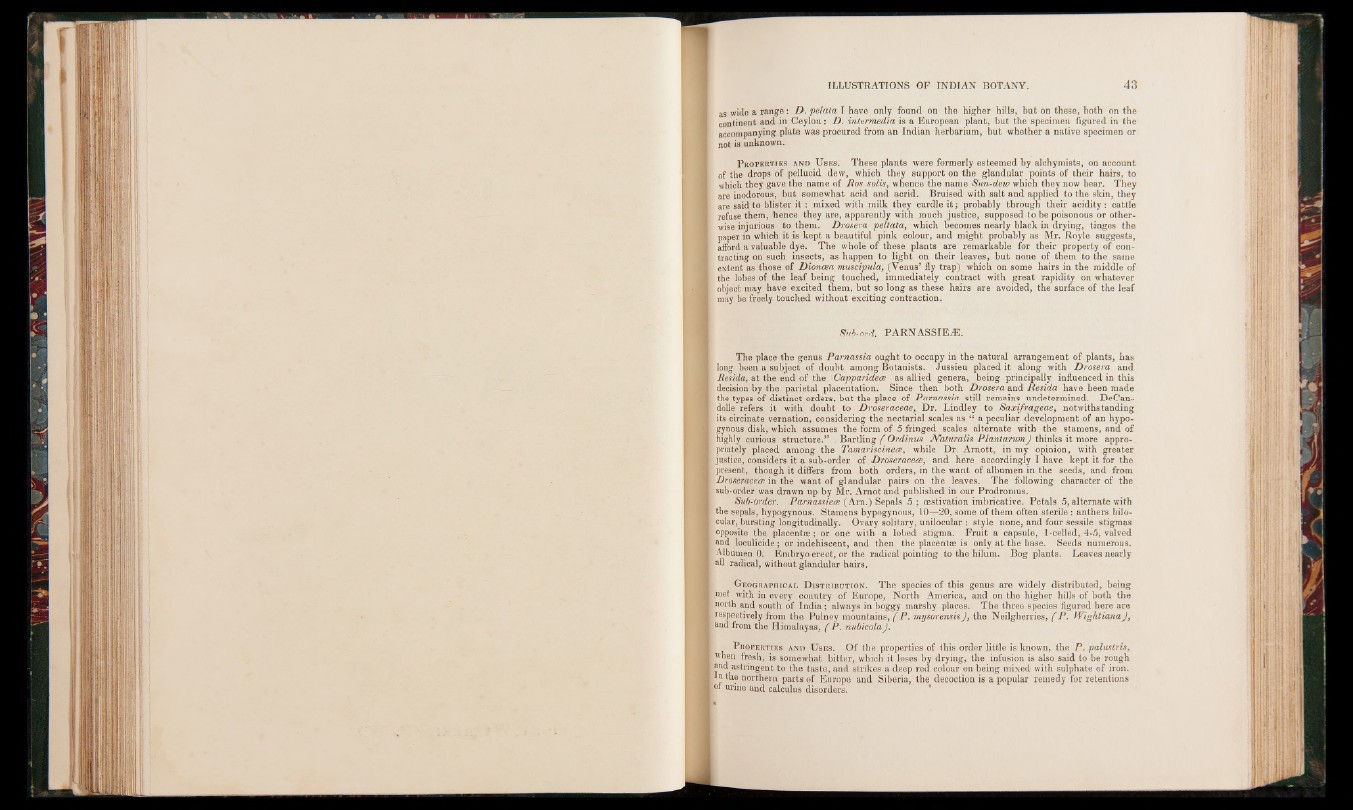
as wide a range: D. pelata I have only found on the higher hills, but on these, both on the
continent and in Ceylon: D. intermedia is a European plant, but the specimen figured in the
accompanying plate was procured from an Indian herbarium, but whether a native specimen or
not is unknown.
P ro p erties and U s e s . These plants were formerly esteemed by alchymists, on account
of the drops of pellucid dew, which they support on the glandular points of their hairs, to
which they gave the name of Ros solis, whence the name Sun-dew which they now bear. They
are inodorous, but somewhat acid and acrid. Bruised with salt and applied to the skin, they
are said to blister i t : mixed with milk they curdle i t ; probably through their acidity: cattle
refuse them, hence they are, apparently with much justice, supposed to be poisonous or otherwise
injurious to them. Drosera peltata, which becomes nearly black in drying, tinges the
paper in which it is kept a beautiful pink colour, and might probably as Mr. Royle suggests,
afford a valuable dye. The whole of these plants are remarkable for their property of contracting
on such insects, as happen to light on their leaves, but none of them to the same
extent as those of Dionoea muscipula, (Venus’ fly trap) which on some hairs in the middle of
the lobes of the leaf being touched, immediately contract with great rapidity on whatever
object may have excited them, but so long as these hairs are avoided, the surface of the leaf
may be freely touched without exciting contraction.
Sub-ord. PARNASSIEA2.
The place the genus Parnassia ought to occupy in the natural arrangement of plants, has
long been a subject of doubt among Botanists. Jussieu placed it along with Drosera and
Resida, at the end of the Capparidece as allied genera, being principally influenced in this
i decision by the parietal placentation. Since then both Drosera and Resida have been made
the types of distinct orders, but the place of Parnassia still remains undetermined. DeCan-
dolle refers it with doubt to Droseraceae, Dr. Lindley to Saxifrageae, notwithstanding
its circinate vernation, considering the nectarial scales as “ a peculiar development of an hypo-
i gynous disk, which assumes the form of 5 fringed scales alternate with the stamens, and of
highly curious structure.” , Bartling ( Ordinus Naturalis Plantarum) thinks it more appropriately
placed among the Tamariscinece, while Dr. Arnott, in my opinion, with greater
[ justice, considers it a sub-order of Droseracece, and here accordingly I have kept it for the
present, though it differs from both orders, in the want of albumen in the seeds, and from
Droseracece in the want of glandular pairs on the leaves. The following character of the
| sub-order was drawn up by Mr. Arnot and published in our Prodromus.
Sub-order. Parnassiece (Arn.) Sepals 5 ; aestivation imbricative. Petals 5, alternate with
the sepals, hypogynous. Stamens hypogynous, 10—20, some of them often sterile : anthers bilocular,
bursting longitudinally. Ovary solitary, unilocular : style none, and four sessile stigmas
| opposite the, placentae; or one with a lobed stigma. Fruit a capsule, 1-celled, 4-5, valved
| and loculicide; or indehiscent, and then the placentae is only at the base. Seeds numerous,
j Albumen 0: Embryo erect, or the radical pointing to the hilum. Bog plants. Leaves nearly
all radical, without glandular hairs.
G eographical D is t r ibu t io n . The species of this genus are widely distributed, being
[met with in every country of Europe, North America, and on the higher hills of both the
[north and south of India; always in boggy marshy places. The three species figured here are
respectively from the Pulney mountains, ( P. mysorensisJ, the Neilgherries, ( P. WightianaJ,
[and from the Himalayas, ( P. nubicola).
I P roperties and U s e s . Of the properties of this order little is known, the P. palustris,
j when fresh, is somewhat bitter, which it loses by drying, the infusion is also said to be rough
and astringent to the taste, and strikes a deep red colour on being mixed with sulphate of iron.
|ln the northern parts of Europe and Siberia, the decoction is a popular remedy for retentions
| of urine and calculus disorders.